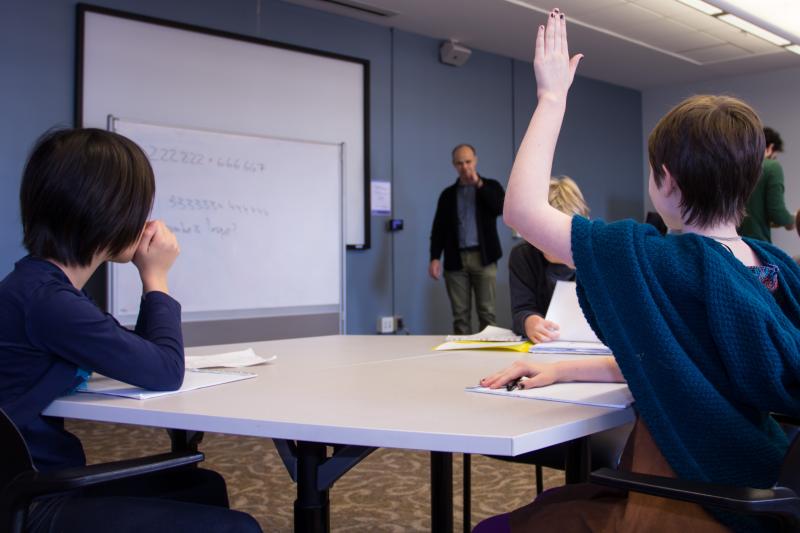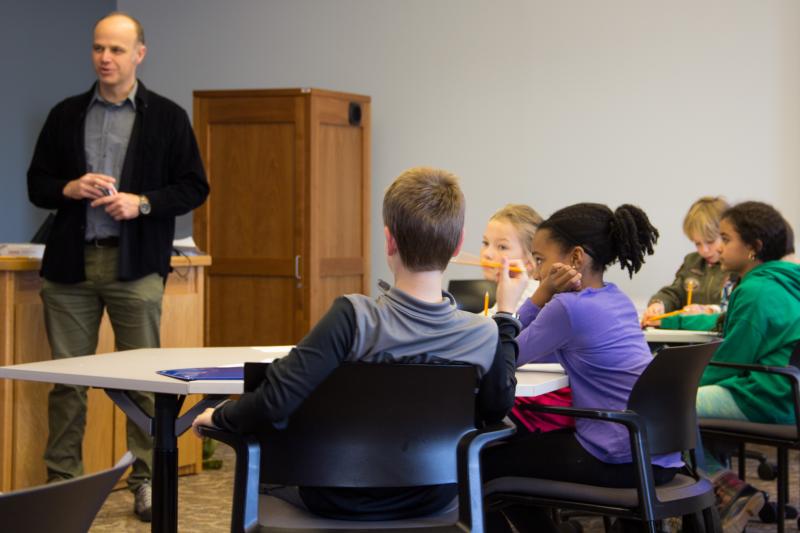Expanding the Circle

The talented mathematicians sat hunched over their calculations as they worked through a series of problems on an unseasonably warm Sunday afternoon last December. Sunlight streamed through the windows of the University of Virginia’s Charles L. Brown Science & Engineering Library, but no one, not even the small number cruncher wearing yellow soccer socks, shin guards and cleats, directed a wistful gaze outdoors as they wrestled with a triangular array of binomial coefficients known as Pascal’s Triangle.

It was only when Professor Slava Krushkal called for a short break that the 14 assembled students reverted back to elementary-school form. A few remained in pairs at their tables, dueling over graph paper as they played extra rounds of the Shannon switching game of strategy introduced earlier by Krushkal, a mathematics professor in UVA’s College and Graduate School of Arts & Sciences. The rest gravitated to the wheelchair ramp at the far corner of the room, giggling as they took turns hanging over the railings now serving as their own personal jungle gym.
“Graduate students will just sit down and work for hours on a problem, but I’ve learned that with kids, you have to entertain them and take breaks,” Krushkal says.
A different approach
Math-enrichment programs for interested young students are no longer uncommon in the United States. For the new Math Circle program that Krushkal launched last fall for 15 local 4th- and 5th-graders nominated by their schools, he looked for inspiration in his own educational experience growing up in Russia. As students achieved fluency in different mathematical concepts, the mathematics curriculum there stressed the importance of students honing their creativity as they think their way through increasingly difficult logic problems. The first Math Circles in the United States were organized by the Mathematical Sciences Research Institute in Berkeley, California. Today, there are more than 200 Math Circles around the country.
With the assistance of Gabriel Islambouli and Michael Reeks, two Ph.D. students in the Department of Mathematics, Krushkal organized a semester-long schedule of Sunday afternoon Math Circle sessions. Setting up the program, he received some guidance from the Curry School of Education, as well as from his faculty colleague and former Department of Mathematics chair Craig Huneke.
“We have many first-rate mathematicians at UVA, and the establishment of Math Circles allows us to use this talent to help K-12 students in our area,” Huneke said. “It is enormously empowering for children to think actively about the solution of mathematical problems, and to develop the solution themselves.
The goal of the program, Krushkal said, is to stoke the curiosity of young students who have displayed an early aptitude for mathematics, while steering away from the rote memorization that may accompany their traditional instruction.
“We are exposing them to logical problems, topology and other concepts that they may never see in school,” Krushkal said. “Some of the things we show them are practical applications of math to real things. Some of them are fun mathematical games that feature deep mathematical principles underneath.”
Earlier in the fall, Krushkal, Islambouli and Reeks introduced the students to “Hex,” a strategic game devised independently in the 1940s by two mathematicians, Piet Hein and John Nash. On another Sunday, Krushkal dipped the frame of a triangular pyramid, built with sticks, into a soap solution. After he pulled the tetrahedron-shaped frame out of the solution, the bubble created within the frame came together at a single point smack in the middle of the open frame. That led to a discussion explaining how bubbles seek stability by minimizing their surface area. Soon, students were crafting other polyhedra out of sticks to make different bubbles.
“The bubbles are beautiful, and the students are saying, ‘Wow!’, and then we discuss the mathematical principles underlying the experiment as we explain how the soap bubbles try to minimize area as they achieve the ultimate shape,” Krushkal said.
Islambouli said it was important for them to present the Math Circle students with interesting problems that not only challenge them, but also reward them for pursuing creative solutions.
“At first, of course, they were a little shy, he said. There’s a lot of ego type stuff tied to math in school, so maybe they were afraid to be seen as dumb. But pretty soon, they realized, ‘Oh, we’re just playing games.’ Once you rephrase it, and they realized they weren’t being graded on their performance, it’s no longer ‘You versus your grade.’ It’s all of us trying to understand a problem together.”
“It’s really great to see some of the students really get into a problem and start arguing with us after we told them what the solution was,” Reeks said. “Even if they were wrong, what really matters is that they had really taken ownership of the solution and the problem. One of the great things this program does is it exposes kids to different perspectives on what math is and how they can use quantitative reasoning in their lives. And I think that’s helpful in heading off this symptom where people say, ‘Oh I’m bad at math,’ or ‘I just don’t like math’ and close themselves off to that forever.”

The UVA Math Circle is taking a break this semester, but Krushkal said he intends to revive it next fall. Parents of the program’s initial class of students said their children are eager to continue in the Math Circle next school year.
Michael Garcia said that the Math Circle program provided his son, a 5th-grade student at Walker Elementary, an opportunity to meet other students his age who share his interest in learning math.
“He was always eager to go and to share what he had learned,” Garcia said. “I appreciated that he was given exposure to university faculty and students, introducing the idea that learning math is a long-term endeavor. The hands-on nature of the class really captured my son’s attention.”
Michele Paige Claibourn’s daughter Fred (short for Winifred) came home from Math Circle eager to challenge her parents to play the strategic math games she learned in the Brown Science & Engineering Library.
“Maybe it’s not the primary intent of the program, but one of the ways it’s really helped Fred is the discovery of how fun it was to be in a room full of other students who also were really excited about math,” Claibourn said. “That shared enthusiasm was new for her in some ways, and I think that as much as anything helped really reinforce to her that, ‘This is cool, and here are some other people my age who also think this is cool.’”




